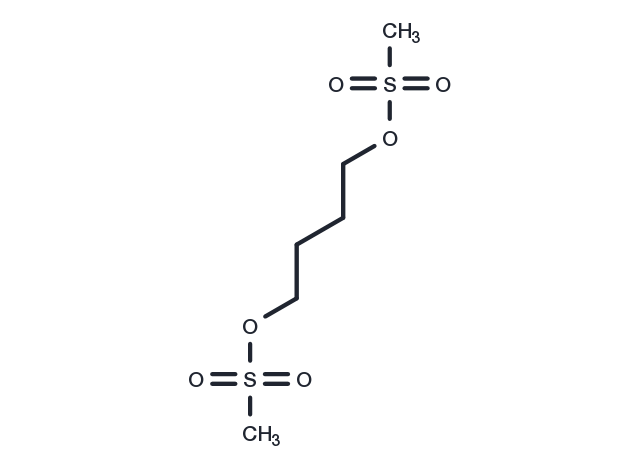Powder: -20°C for 3 years | In solvent: -80°C for 1 year


Busulfan (Busulphan) is a synthetic derivative of dimethane-sulfonate with antineoplastic and cytotoxic properties. Although its mechanism of action is not fully understood, busulfan appears to act through the alkylation of DNA. Following systemic absorption of busulfan, carbonium ions are formed, resulting in DNA alkylation and DNA breaks and inhibition of DNA replication and RNA transcription.

| Pack Size | Availability | Price/USD | Quantity |
|---|---|---|---|
| 500 mg | In stock | $ 45.00 | |
| 1 g | In stock | $ 62.00 | |
| 1 mL * 10 mM (in DMSO) | In stock | $ 50.00 |


| Description | Busulfan (Busulphan) is a synthetic derivative of dimethane-sulfonate with antineoplastic and cytotoxic properties. Although its mechanism of action is not fully understood, busulfan appears to act through the alkylation of DNA. Following systemic absorption of busulfan, carbonium ions are formed, resulting in DNA alkylation and DNA breaks and inhibition of DNA replication and RNA transcription. |
| In vitro | Mice transplanted with busulfan exhibit slow and incomplete lymphoid engraftment. Mice treated with busulfan demonstrate a significant increase in apoptosis and a reduction in testicular weight. In NOD/SCID mice, busulfan treatment combined with irradiation achieves a detection sensitivity similar to that of limiting dilution assays. A dose-dependent lymphoid tissue reconstitution is provided in mice with 20 mg/kg to 100 mg/kg of busulfan. At 40 mg/kg, busulfan induces the maximum number of apoptotic cells while minimizing the number of necrotic cells. |
| In vivo | Busulfan, an alkylating agent that induces DNA damage through cross-linking DNA with DNA and proteins, triggers senescence in normal human diploid WI38 fibroblast cells via a cascade mediated by extracellular signal-regulated kinase (Erk) and p38 mitogen-activated protein kinase (p38 MAPK), independent of the p53-DNA damage pathway. Busulfan causes a transient reduction in glutathione levels, followed by a sustained increase in ROS production. The hypophosphorylation of Rb induced by Busulfan inhibits the expression of PCNA in testicular cells, preventing apoptosis of spermatogonial stem cells. Moreover, while Busulfan reduces the frequency of cobblestone area-forming cells, it does not significantly increase apoptosis in hematopoietic stem cells (HSC)-like cells and progenitor cells with similar phenotypes. Busulfan suppresses the hematopoietic function of HSC-like cells and progenitor cells through an apoptosis-dependent mechanism. Additionally, Busulfan-induced senescence in bone marrow hematopoietic cells correlates with a time-dependent increase in the expression of p16Ink4a and p19Arf. |
| Synonyms | Myleran, Sulphabutin, Busulphan |
| Molecular Weight | 246.3 |
| Formula | C6H14O6S2 |
| CAS No. | 55-98-1 |
Powder: -20°C for 3 years | In solvent: -80°C for 1 year
Ethanol: < 1 mg/mL (insoluble or slightly soluble)
DMSO: 46 mg/mL (186.8 mM)
You can also refer to dose conversion for different animals. More
bottom
Please see Inhibitor Handling Instructions for more frequently ask questions. Topics include: how to prepare stock solutions, how to store products, and cautions on cell-based assays & animal experiments, etc.
Busulfan 55-98-1 Apoptosis DNA Damage/DNA Repair DNA Alkylator/Crosslinker DNA Alkylation inhibit Inhibitor Myleran Sulphabutin Busulphan inhibitor
